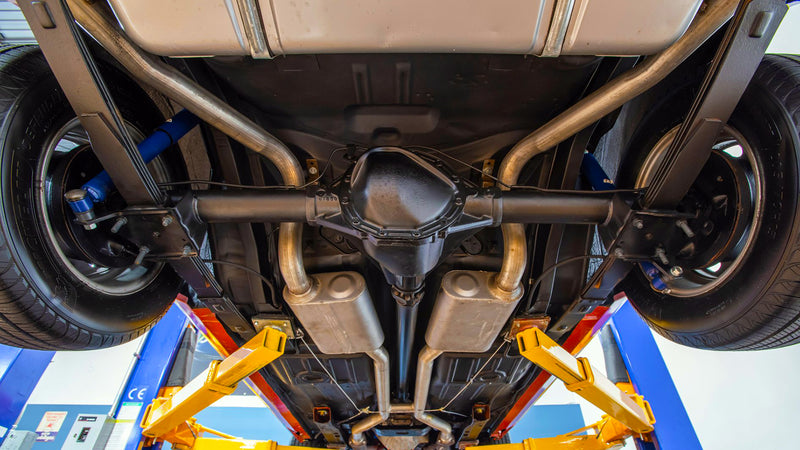What Are Staggered Rear Brakes?
Posted on

Staggered brakes have nothing to do with tire stagger or staggered wheels. Tire stagger puts smaller diameter tires on the left side of the car in circle track racing to make it turn easier. Staggered wheels put wider or larger diameter tires on the back of the car compared to the front.
So what are staggered brakes?
Staggered brakes mount one caliper in front of, and one behind the axle. This has everything to do with staggered shock absorber mounting, which puts one shock in front and one behind the rear axle. Wilwood makes about 15 different rear brake kits that are staggered.
Shocks that are staggered mount one to the front of the rear axle and one behind, and depending on the design of the suspension, can interfere with brake caliper mounting. Staggered shock mounting is fairly common on cars and trucks with rear leaf spring suspensions even today. First generation Camaros, Firebirds, Mustangs, and related vehicles varied year by year, and sometimes just based on original engine and transmission options, so Wilwood created kits for both standard and staggered designs.
When the first Camaros and Firebirds rolled out of Detroit in 1967, both rear shock absorbers were mounted ahead of the axle. Buyers, and dealer service departments, quickly learned that enthusiastic applications of the throttle would cause "tire hop" and often time, broken parts. The issue was that the rear axle would rotate opposite of what the rear wheels were doing, causing the leaf spring to deform to an S-shape. Then the tires would lose traction, the spring would snap back, the tires would bite, and it would all happen again.
The quick fix, applied in '67 as a running change on the assembly line, was a "radius rod" or traction bar, running parallel to the leaf springs on higher performance cars.
For 1968 onward, Chevy and Pontiac moved the driver side rear shock absorber behind the axle, while the other side stayed ahead. Now when the spring deformed, it was extending one shock, and when it bounced back it extended the opposite one, damping the axle wrap.
This fixed the wheel hop so well that Ford engineered a staggered setup for higher powered 1968 Mustangs and included it in the "Competition Suspension" option on later year cars. All of the second generation F-body and Mustang II cars used staggered shock mounting.
How and why did it work? The new location and angle of the shock allowed it to dampen, somewhat, the forces twisting the spring around the axle. The damping was enough to stop the harmonics of the spring, tire, and traction from amplifying each other by being near the same frequency. Why not move both shocks behind the axle? Because axle wrap can occur when you step on the brakes as well, only in the opposite direction.
If you have upgraded your rear suspension with traction bars, modified leaf springs, or a control arm and coil spring set up, there is no longer any need for staggered shocks. In fact, many aftermarket rear suspension systems require moving the shocks, because they can be in the way otherwise.
Many pickup trucks, SUVs, and vans using leaf springs still employ staggered shocks to reduce axle wrap and wheel hop. But on most of these, the shocks are mounted inboard of the leaf springs, so they don't have much effect on the brake caliper.
Why does Wilwood have specific brake kits designated as staggered? Because all you Camaro, Nova, Firebird, Mustang, Maverick, and Cougar owners asked us for them. But because of the optional nature of staggered shocks on some models, and year-to-year changes, we engineered the same kits in normal, non-staggered installation as well. This is one of the many reasons Wilwood rear kits are sold based on rear axle flange and offset and not just make, model, and year like our front kits.
What is the difference between the staggered and normal kit? There actually is not much difference in most kits, except for the caliper bracketry and/or parking brake backplate. In a regular kit, the brackets are mirror images of each other. In a staggered kit, both brackets are almost the same part, because you install it reversed on one side, to move the caliper to the reversed side of the axle.
So, if you are working on a classic car/truck with leaf springs, take a look underneath and make a note of whether it has staggered shocks or not. Keep that information in mind as you measure the axle flange and offset, and shop for rear kits.
Big Ford - New Style (Torino) 2.50" axle offset - 140-13677, 140-9560, 140-11392, 140-12236
Chevy 10/12 Bolt - 2.75" axle offset - 140-13678, 140-9315, 140-14400, 140-12570
Chevy 10/12 Bolt - 2.81" axle offset - 140-10908
Chevy 10/12 Bolt C-clip Eliminator - 140-14259
Buick/Olds/Pontiac 1964-70 - 140-16989, 140-16988
Chevy (special) - 2.75" axle offset - 140-11400
Chevy (special) - 2.81" axle offset - 140-10918, 140-13025
0 comments